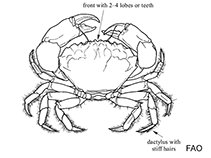Myomenippe hardwickii (Gray, 1831)
Mangrove stone crabWarning: DOMDocument::load(): SSL operation failed with code 1. OpenSSL Error messages: error:140770FC:SSL routines:SSL23_GET_SERVER_HELLO:unknown protocol in C:\Apache24\htdocs\includes\SpeciesSummary.lib.php on line 1236
Warning: DOMDocument::load(): Failed to enable crypto in C:\Apache24\htdocs\includes\SpeciesSummary.lib.php on line 1236
Warning: DOMDocument::load(https://sealifebase.nrm.se/webservice/AquaMaps/getAMap.php?genus=Myomenippe&species=hardwickii): failed to open stream: operation failed in C:\Apache24\htdocs\includes\SpeciesSummary.lib.php on line 1236
Warning: DOMDocument::load(): I/O warning : failed to load external entity "https://sealifebase.nrm.se/webservice/AquaMaps/getAMap.php?genus=Myomenippe&species=hardwickii" in C:\Apache24\htdocs\includes\SpeciesSummary.lib.php on line 1236
Hochladen Photos
Google Bild | No image available for this species;
drawing shows typical species in Menippidae.
Google Bild | No image available for this species;
drawing shows typical species in Menippidae.
Classification / Names Common names | Synonyms | CoL | ITIS | WoRMS
| Decapoda | Menippidae
Environment: milieu / climate zone / depth range / distribution range Ökologie
Riff-verbunden. Tropical
Verbreitung Länder | FAO Gebiete | Ecosystems | Vorkommen | Einführungen
Western Central Pacific: throughout Southeast Asia, reaching the Philippines.
Length at first maturity / Size / Gewicht / Alter
Maturity: Lm ? range ? - ? cm Max length : 10.0 cm CW Männchen/unbestimmt; (Ref. )
Kurzbeschreibung Morphologie
Carapace ovate, covered with numerous very small granules; regions well defined; 4 broad lobiform teeth on each anterolateral margin. Eyes green in life. A larger molariform tooth at base of movable finger of larger chela. Carapace dirty-brown overall; eyes green, fingers black.
Occurs from shallow water to intertidal zones. Inhabits mangrove areas and prefers rocky areas, or areas densely covered by bivalves, such as Perna spp. Benthic. Tropical climate (Ref. 343).
Life cycle and mating behavior Geschlechtsreife | Fortpflanzung | Ablaichen | Eier | Fecundity | Larven
Members of the order Decapoda are mostly gonochoric. Mating behavior: Precopulatory courtship ritual is common (through olfactory and tactile cues); usually indirect sperm transfer.
Hauptreferenz
Referenzen | Koordinator | Partner
Ng, P.K.L. 1998. (Ref. 343)
IUCN Rote Liste Status (Ref. 130435)
CITES Status (Ref. 108899)
Not Evaluated
CMS (Ref. 116361)
Not Evaluated
Bedrohung für Menschen
Harmless
Nutzung durch Menschen
| FishSource |
Tools
Mehr Information
Internet Quellen
BHL | BOLD Systems | CISTI | DiscoverLife | FAO(Publication : search) | Fishipedia | GenBank (Genom, nucleotide) | GloBI | Gomexsi | Google Books | Google Scholar | Google | PubMed | Tree of Life | Wikipedia (Gehe zu, Suchen) | Zoological Record
Estimates based on models
Preiskategorie
(Ref. 80766):
Unknown.



